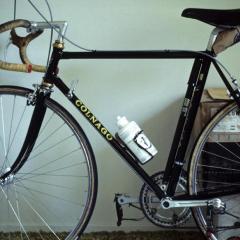-
Recently Browsing
- No registered users viewing this page.
-
Topics
-
Posts
-
Since it is running for a while, that is a very good sign. It will eventually respond well to probably a basic clean and lubrication. The movements powering watches like this tend to be quite commonplace and easy to source donor parts for. That's a guess based on past experience, but please post a photo of the insides when you can. Standard warnings apply: if you can't find someone to service this for you and decide to dive in, do not start out with your heirloom! Practice on several other similar watches first until you get the hang of it. On ebay you will find a big supply of mid 20thC military style watches, and there's a good chance a lot of them have the same movement as yours. Welcome and good luck!
-
By nevenbekriev · Posted
Hi Alan, First of all, I would'n worry about a hammer bearing wear as much as You do, espscially if a microscope is needed to see the wear. No matter, the bushing in pocket watches bearings doesn't differ from the clocks ones, just the scale is different. You will need to make smaller bush in smaller hole. Acuracy is needed to make the things look good, as the result is seen on top of the movement. Usually it is harder to repair the verge side bearing for the crown wheel of small werge movements, as there is verry small surface and the plate is really thin, there it is beter to solder the bush than just press it, and riveting the bush in this specific bearing is bad idea -
I had to go back to the beginning which is why quoted something so you purchased a 1972 watch. In other words a 52-year-old watch. Then testing with the phone app as far as I'm concerned typically is a waste of time. Typically phone apps use the microphone of the phone which is not designed for picking up properly the sounds of the watch and often times we've had well basically phone apps are a waste of time. You really need to get something better for diagnosing and looking at watch problems. So basically we have a 52-year-old watch that conceivably has never been serviced that is now having issues. The condition of the rest the watch would be visual observation typically when disassembling for a complete service or if the watches it all running a decent timing machine of some sort versus a worthless phone app. Until you disassemble the mainspring you don't actually know if it's broken or not and if the watches never been serviced yes mainsprings break. Even unbreakable mainsprings break. But the problem with the mainspring is it's in the mainspring barrel and we don't have x-ray vision so the mainspring barrel has to be disassembled. Oh and Seiko's it looks easier than this watch doesn't it? But is it easier? Sometimes looks can be deceiving whereas as others have pointed out this is just a decent mechanical watch with an automatic that action looks quite simple versus the Seiko that looks simple that typically has a lot of wheels under a full plate. Also unlike a Seiko you can remove the automatic and this becomes a manual watch. So as others of said it's not really a super complicated watch it just looks complicated but. You really need to practice disassembling and reassembling even just one watch even possibly for an entire week or two. Ever wonder how the students in school at least serious professional schools get so good by practicing on the same watch over and over and over again. Need to practice and to have a real good feel for what you're doing and then a complete service of this watch I think as opposed to a Band-Aid fix of a new mainspring as we do not really know the condition of the watch at all or anything else is going on.
-
By Neverenoughwatches · Posted
Here is an evapouration test of 5 solvent type fluids in common use for cleaning watch parts , and for a comparison a proprietary cleaner. The list in order of testing and result is as follows 1. Lighter fluid 2. IPA 3. Methylated spirits 4. Acetone 5. Kerosene 6. Elma ammoniated. This maybe helpful in determining how good their cleaning ability is. The testing was kept fairly strict as far as a diy approach can be. A cupped mirror was used to place a single drop of fluid at it's center and timed until the drop completely evaporated or i ended the test, the mirror was throughly cleaned with IPA and dried between each test. Each picture is in order of the test starting with picture 3. My thoughts and notes are pic 3. The lighter fluid left quite a thick layered stain. 4. IPA was less stained. 5. Meths was very light on staining but left a thin outside ring and droplets at the center that would not evaporate ( possibly contamination in the meths ? ) 6. Acetone was by far the fastest evaporation rate leaving again light staining but a heavier outer ring stain. Pic 7. Kerosene which was interesting, very low evaporation rate but a high wetting nature that climbed the whole of the mirror walls in 6 minutes, even with heat from a hairdryer the kerosene would not evaporate. Pic 8. Elma ammoniated which did not evaporate or move at all for 8 minutes and pic 9. needed extra 5 minutes of heat to dry out completely . Pic 10. Is the mess from the dry Elma fluid when i tried to clean the mirror. Make your own conclusions from these results.
-







Recommended Posts